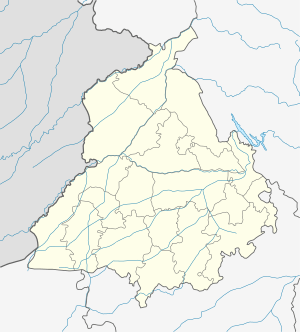Jandiala Guru
Jandiala Guru, commonly known as Jandiala, is a town; it is located in Amritsar district, Majha region, Eastern Punjab, India. It is located on the Grand Trunk Road,[2] and has an altitude of 229 m (754 ft).[3]
Jandiala Guru | |
|---|---|
Town | |
| Nickname(s): City of Seven Gates | |
 Jandiala Guru Location in Punjab, India  Jandiala Guru Jandiala Guru (India) | |
| Coordinates: 31°33′41″N 75°1′36″E | |
| Country | |
| State | Punjab |
| Region | Majha |
| District | Amritsar |
| Population (2011) | |
| • Total | 29,232[1] |
| Languages | |
| • Official | Punjabi |
| Time zone | UTC+5:30 (IST) |
| PIN | 143115 |
| Vehicle registration | PB-02 |
| Nearest city | Amritsar |
| Website | www.jandialaguru.com |
History
Jandiala Guru is named after Jand, the son of the founder.[4] The municipality was created in 1867 during the colonial period of British rule and formed part of Amritsar Tehsil. The town was situated on the route of the North-Western Railway. The population according to the 1901 census was 7,750, and the revenue of the town in 1903-4 was Rs. 8,400, mainly from octroi taxes.
Previously, it was surrounded by a mud wall and had seven gates. Some of these gates, at least their ramparts are still intact.
At the turn of the 21st century the population was estimated at about 100,000. Large communities are Ghangas (Jatts), Jains (mainly jewelers, grain Merchants, and businessmen), Malhotras (Khatri), Kamboj & Thatheras (utensil makers), Harijans and Christians. Large concentration of these skillful artisans make Jandiala Guru the hub for jewelry and utensils for the surrounding areas.
Previously, it was surrounded by a mud wall and had seven gates. Some of these gates or their outside remains can still be seen.
The town has religious diversity. A number of popular and well visited religious places for Sikhs, Hindus, Jains and Muslims exist in and around the town. A historical Gurudwara of Baba Handal (Baba Handal Tap Asthan) is well known and well visited religious place.
A crafts colony of Thatheras was established during the reign of Maharaja Ranjit Singh (1883) the great 19th Century Sikh Monarch, who encouraged skilled metal crafters from Kashmir to settle here.[5]
In 2014, the traditional brass and copper craft of utensil making among the Thatheras of Jandiala Guru got enlisted on the List of Intangible Cultural Heritage by UNESCO.[6] After the listing, the Deputy Commissioner of Amritsar launched Project Virasat to revive this craft.[7]
References
- "Census of India 2001: Data from the 2001 Census, including cities, villages and towns (Provisional)". Census Commission of India. Archived from the original on 16 June 2004. Retrieved 1 November 2008.
- "Jandiāla Gurū – Imperial Gazetteer of India, v. 14, p. 55". Dsal.uchicago.edu. Retrieved 29 August 2012.
- "Location of Jandiala Guru – Falling Rain Genomics". Fallingrain.com. Retrieved 29 August 2012.
- "City of Seven Gates". Tribune India. Retrieved 29 August 2012.
- "Traditional brass and copper craft of utensil making from Punjab gets inscribed on the Representative List of the Intangible Cultural Heritage of Humanity, UNESCO, 2014". pib.nic.in. Retrieved 1 July 2019.
- "UNESCO - Traditional brass and copper craft of utensil making among the Thatheras of Jandiala Guru, Punjab, India". ich.unesco.org. Retrieved 1 July 2019.
- Jun 24, Yudhvir Rana | TNN | Updated; 2018; Ist, 11:15. "Jandiala utensils: Age-old craft of thatheras to get new life | Chandigarh News - Times of India". The Times of India. Retrieved 1 July 2019.CS1 maint: numeric names: authors list (link)